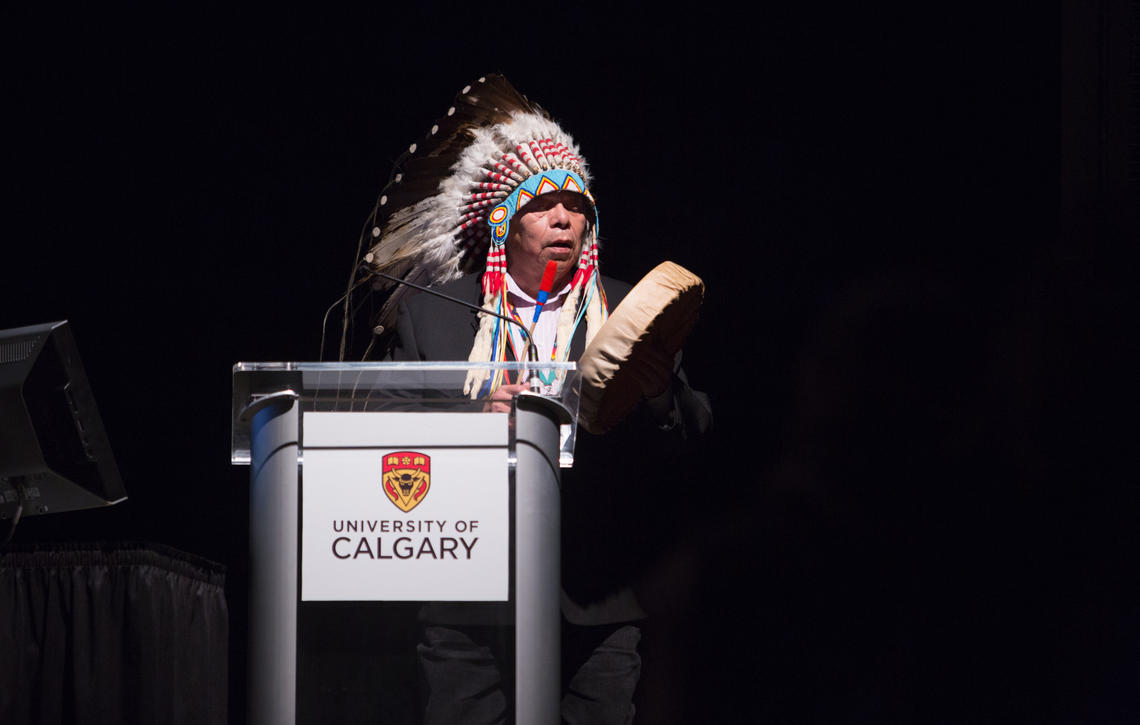Feb. 5, 2018
Douglas Cardinal encourages Indigenous students to follow their own path to design careers

Douglas Cardinal was born in Depression-era Alberta and attended a residential school in Red Deer in the 1940s. While for most, it would’ve been nearly impossible to imagine an Indigenous architect in Canada, Cardinal’s mother couldn’t think of any better way for her son to explore his budding talents.
“My mother is the one that wanted me to be an architect. She spent a great deal of time teaching me about the arts — music and art and history of architecture,” says Cardinal.
“I was exposed to great architects of the past by what I saw in books,” he adds. “I immersed myself in all the architecture.”
Born in Calgary, Cardinal embarked on a celebrated career that includes major works such as the Canadian Museum of History in Gatineau, Que. (1989) and the National Museum of the American Indian in Washington, D.C. (1998).
- Photo above: Distinguished Canadian architect Douglas Cardinal gives the keynote presentation at the Faculty of Environmental Design's Indigenous Design Thinking symposium. The event encourages Indigenous students to pursue careers in architecture, planning and landscape architecture. Photos by Riley Brandt, University of Calgary
Now 83, and still engaged in a thriving career as an internationally renowned architect, Cardinal wants to encourage young Indigenous students to find their own pathways into design careers. He gave two keynote addresses during the first Indigenous Design Thinking Symposium, organized by the Faculty of Environmental Design, on Jan. 25. The event attracted more than 600 participants and is part of a broader strategy by the faculty to attract Indigenous students.

Blackfoot Elder Kelly Good Eagle Sr. performs the opening prayer at the Indigenous Design symposium.
Cardinal says his experiences growing up in a residential school helped inform his drive for change in architecture.
“I was concerned about the environment and how buildings didn’t truly fulfill the needs of people, particularly schools,” says Cardinal. “At the time, I remember feeling the schools were just warehousing children and it was not a good environment to bring up children in. I felt that somehow I’d like to change that.”
Cardinal is renowned for his curvilinear designs that reflect the Indigenous landscapes of Alberta, which he blends seamlessly with his interest in European Expressionist architecture, especially the work of Austrian architect and philosopher Rudolph Steiner.
For Cardinal, the spiritual life, the environment and the needs of the people who use buildings should never be separate from the design and construction of the public structures we use.
“Architects are almost like high priests of the system. You physically embody the symbols of civilization in buildings, and I saw those symbols as oppressive, colonizing structures all about power and control,” says Cardinal. “They didn’t serve the people they were supposed to be serving. They served the institutions of the people that were in them.
“I felt I would like to be an architect to provide facilities that would truly serve the people.”

Douglas Cardinal spoke to high school students from Calgary and surrounding Indigenous communities.
Cardinal now looks back on a career full of achievement having received more than a dozen honorary doctorates, gold medals in architecture in Canada and Russia, a best sustainable village award from UNESCO, and he was declared a World Master of Contemporary Architecture by the International Association of Architects. He is also an Officer of the Order of Canada.
Currently, Cardinal is a co-curator for Canada’s entry at the prestigious 2018 Venice Architecture Biannale. The Canadian exhibition Unceded: Voices Of The Land will bring together the work of Indigenous designers who work all over North America and put them under an international spotlight alongside some of the top talent in their field.
This impulse to promote Indigenous talent also includes a desire to provide opportunities to break down barriers among Indigenous youth. This is why he wanted to take part in the Indigenous Design Thinking symposium along with six Indigenous designers and educators, including four alumni from the Faculty of Environmental Design. He even took some time ahead of the program to meet and talk with high school students from Calgary and surrounding Indigenous communities.
The event was the first major symposium held on campus since the University of Calgary unveiled its Indigenous Strategy, ii' taa' poh' to' p, on Nov. 16, 2017. The strategy was the result of nearly two years of community dialogue and campus engagement, and involved the work of a number of people from the university, Indigenous communities and community stakeholders.
“This event provided an amazing opportunity for students, staff, faculty and community members to learn about Indigenous ways of knowing and doing in creative and innovative design concepts in architecture,” says Shawna Cunningham, director, Indigenous strategy. “Together, the keynote address by Douglas Cardinal and the presentations from the talented and accomplished Indigenous architects covered a great deal of ground — from Indigenous ways of knowing and doing in the creative process, to the importance of community inclusion in architectural design projects, to innovative experiential ways of teaching and learning in architecture.”
The University of Calgary unveiled its Indigenous Strategy, ii' taa' poh' to' p, on Nov. 16, 2017. The strategy is the result of nearly two years of community dialogue and campus engagement, and involved the work of a number of people from the university, Indigenous communities and community stakeholders. Recommendations from the strategy are being implemented as we move forward with promise, hope and caring for the future.
Douglas Cardinal on architecture and Indigenous Design Thinking
Canadian architect Douglas Cardinal discusses his career in environmental design: his education, his influences and the importance of Indigenous perspectives.
University of Calgary
